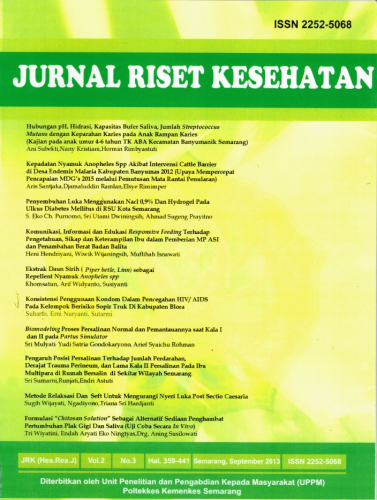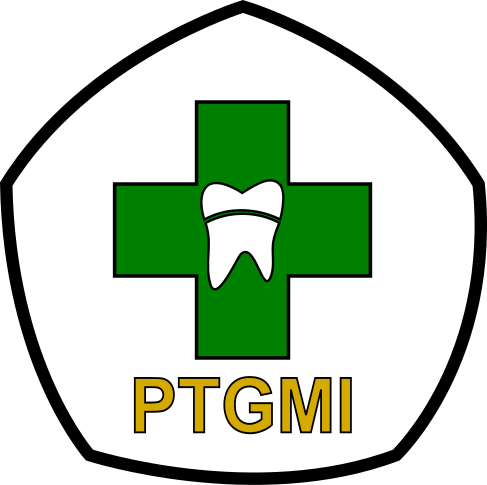PERCEPTIONS OF TRADITIONAL MEDICINES FOR SELF-MEDICATION AMONG PEOPLE IN DIENG PLATEAU CENTRAL JAVA PROVINCE, INDONESIA
Abstract
Traditional medicines are commonly used in the community. One type of traditional medicines that is popular among people is "jamu". "Jamu" can be made from plants, animals, minerals, or a mixture of them that has been used for generations based on empiric experience. This study aimed to describe perceptions of the use of traditional medicines for self-medication among people in Dieng Plateau, Kejajar, Wonosobo, Central Java Province. This is a descriptive study with a qualitative approach. Respondents were adults more than 18 years old who had experience in using traditional medicines and were selected with non-random accidental sampling. Thirty-one (31) respondents signed informed consent. Data were collected using an interview guideline and analyzed using enumerative approach. Most of the respondents used traditional medicines for self-medication one to five times a month. They expressed that traditional medicine is like "Jamu", primarily liquid, with limited or no side effects. Traditional medicine was mostly obtained from local groceries at affordable prices. Most of the respondents have a positive attitude towards the use of traditional medicines. They have the willingness to use traditional medicines to deal with their symptoms or minor illnesses. Their satisfaction experience in using traditional medicine will motivate them to do so in the future. Based on the results, it can be said that traditional medicines have an important role in the health care system particularly for self-medication.
Keywords
Full Text:
PDFReferences
Awad, A., & Al-Shaye, D. (2014). Public awareness, patterns of use and attitudes toward natural health products in Kuwait: A cross-sectional survey. BMC Complementary and Alternative Medicine. https://doi.org/10.1186/1472-6882-14-105
BPOM RI. (2004). Keputusan Kepala Badan Pengawas Obat dan Makanan Republik Indonesia Nomor HK.00.05.4.2411 tentang Ketentuan Pokok Pengelompokan dan Penandaan Obat Bahan Alam.
Conner, M., & Norman, P. (2005). Predicting Health Behaviour: Research and Practice with Social Cognition Models. In Predicting Health Behaviour (pp. 127–160). https://doi.org/10.1016/S0925-7535(97)81483-X
Darwati, I., & Roostika, I. (2006). Status of Research in Purwoceng (Pimpinella alpina Molk.) In Indonesia. Buletin Plasma Nutfah, 12(1), 9–15. https://doi.org/10.21082/blpn.v12n1.2006.p9-151
Elo, S., & Kyngäs, H. (2008). The qualitative content analysis process. Journal of Advanced Nursing, 62(1), 107–115. https://doi.org/10.1111/j.1365-2648.2007.04569.x
Ervina, L., & Ayubi, D. (2018). Peran Kepercayaan Terhadap Penggunaan Pengobatan Tradisional Pada Penderita Hipertensi Di Kota Bengkulu. Perilaku Dan Promosi Kesehatan, 1(1), 1–9.
Harmanto, N., & Subroto, M. A. (2007). Pilih Jamu dan Herbal Tanpa Efek Samping. PT. Elex Media Komputindo Gramedia.
Ismail. (2015). Faktor Yang Mempengaruhi Keputusan Masyarakat Memilih Obat Tradisional Di Gampong Lam Ujong. Idea Nursing Journal, VI(1), 7–14.
Ismarani. (2013). Kajian Persepsi Konsumen Terhadap Penggunaan Obat Herbal ( Kasus di Unisma Bekasi). CEFARS; Jurnal Agribisnis Dan Pengembangan Wilayah, 4(2), 52–63.
KEMENKES RI. (2013). Riset Kesehatan Dasar (RISKESDAS) 2013. In Kemenkes RI (Issue 1). https://doi.org/10.1007/s13398-014-0173-7.2
Lesmana, H., Alfianur, Utami, P. A., Retnowati, Y., & Darni. (2018). Pengobatan Tradisional Pada Masyarakat Tidung Kota Tarakan: Studi Kualitatif Kearifan Lokal Bidang Kesehatan. MEDISAINS: Jurnal Ilmiah Ilmu - Ilmu Kesehatan, 16(1), 31–41.
Moser, A., & Korstjens, I. (2018). Series: Practical guidance to qualitative research. Part 3: Sampling, data collection and analysis. European Journal of General Practice, 24(1), 9–18. https://doi.org/10.1080/13814788.2017.1375091
Pokja Sanitasi Kabupaten Wonosobo. (2012). Buku Putih Sanitasi Kabupaten Wonosobo Provinsi Jawa Tengah.
Rachman, W. A., & Wardhana, R. A. (2011). Perilaku Etnik Mandar Terhadap Pengobatan Tradisional di Kabupaten Polewali Mandar (Studi Perilaku dengan Pendekatan Etnografi di Kecamatan Balanipa, Kabupaten Polewali Mandar). MKMI, 7(2), 93–104.
Rahayu, M., Rugayah, Praptiwi, & Hamzah. (2002). Keanekaragaman pemanfaatan tumbuhan obat oleh suku Sasak di Taman Nasional Gunung Rinjani-Nusa Tenggara Barat. Prosiding Simposium Nasional II Tumbuhan Obat Dan Aromatik.
Supardi, S., Herman, M. J., & Yuniar, Y. (2011). Penggunaan Jamu Buatan Sendiri di Indonesia (Analisis Data Riset Kesehatan Dasar Tahun 2010). Buletin Penelitian Sistem Kesehatan, 14(4), 375–381.
Supardi, S., Jamal, S., & Raharni. (2005). Pola Penggunaan Obat, Obat Tradisional dan Cara Tradisional dalam Pengobatan Sendiri di Indonesia. Bul. Penel. Kesehatan, 33(4), 192–198.
Suswardany, D. L., Sibbritt, D. W., Supardi, S., Chang, S., & Adams, J. (2015). A critical review of traditional medicine and traditional healer use for malaria and among people in malaria-endemic areas: Contemporary research in low to middle-income Asia-Pacific countries. In Malaria Journal. https://doi.org/10.1186/s12936-015-0593-7
Tilaar, M., Wih, W. ., & Setiadi-Rianti, A. (2011). Pioneers in Green Science (Beberapa Model Penerapan Konsep Ramah Lingkungan di Indonesia). Dian Rakyat.
Tilaar, M., Wih, W. L., & Ranti, A. S. (2010). The Green Science of Jamu. Dian Rakyat.
Widayati, A. (2013). Swamedikasi di Kalangan Masyarakat Perkotaan di Kota Yogyakarta. Jurnal Farmasi Klinik Indonesia, 2(4).
Widayati, A., & Wulandari, E. T. (2018). Edukasi Manfaat Tanaman Obat dan Pengolahannya dengan Metode CBIA di Desa Bulusulur , Kabupaten Wonogiri , Jawa Tengah. Abdimas Altruis: Jurnal Pengabdian Kepada Masyarakat, 1(1), 25–30.
Zhang, X. (2000). General Guideline for Methodologies on Research and Evaluation of Traditional Medicine. World Health Organisation.
DOI: https://doi.org/10.31983/jrk.v10i2.7692
Article Metrics
Refbacks
- There are currently no refbacks.
Copyright (c) 2021 Jurnal Riset Kesehatan




















































